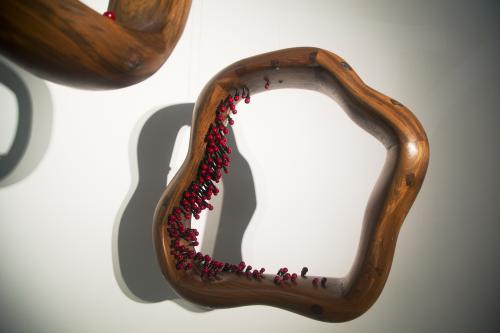'Earth Songs for a Night Sky' by Ranjani Shettar

Earth Songs for a Night Sky, a multi-faceted project by Ranjani Shettar (b. 1977, Bangalore, India) is on exhibit through August 25, 2019 at The Phillips Collection. Hear from the artist on May 16 at 6:30 pm
Drawing from her environment in rural India—with changing skies, monsoon rains, and lush vegetation—and employing traditional materials such as teak wood and indigo pigment, and techniques of carving, dyeing, and lacquer, Shettar has created hand-carved wood sculptures and a multi-part piece that wraps up the gallery walls. Occupying two rooms and the staircase of the original Phillips House, the project is conceived in dialogue with Wassily Kandinsky’s artist’s book Klänge (Sounds)—which features 56 woodcuts and was published right after he had made his breakthrough into abstraction—and Paul Klee’s late paintings in the Phillips’s collection: Arab Song (1932), Efflorescence (1937), and Figure of the Oriental Theater (1934). For Shettar, the connection between her work and Kandinsky’s book and Klee’s paintings is more metaphysical than visual. As she says, “I relate to the surreal and abstract qualities of both Kandinsky’s poetry and images. In Klee, I find a formal and thematic playfulness that I strive to achieve in my own work.” Undeniably, what the work of the three artists have in common is a tension between the material world and spiritual aspirations, observation and introspection, and the act of seeing, making, and reflecting.
Shettar lives and works in the Shimoga district of Karnataka in India. Her artwork has been exhibited and collected by the Metropolitan Museum of Art, Museum of Modern Art, and Guggenheim Museum, New York; San Francisco Museum of Modern Art; Walker Art Center, Minneapolis; the National Gallery of Victoria, Melbourne; and Kiran Nadar Museum of Art, New Delhi; among others.
This show is part of Intersections, a series of contemporary art projects that explores—as the title suggests—the intriguing intersections between old and new traditions, modern and contemporary art practices, and museum spaces and artistic interventions. Whether engaging with the permanent collection or diverse spaces in the museum, the projects suggest new relationships with their own surprises.
*/
Many of the projects also riff on the nontraditional nature of the museum's galleries, sometimes activating spaces that are not typical exhibition areas with art produced specifically for those locations.





